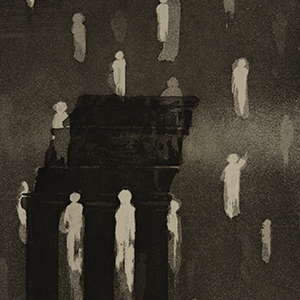

What better season than autumn to contemplate the meaning of hell. Specifically, Dante Alighieri’s Inferno, one third of his 14th-century poem, The Divine Comedy. The artist Michael Mazur created a series of etchings to accompany a translation of the work by Robert Pinsky, a former U.S. Poet Laureate (1997-2000).
Mazur’s monochromatic response L’Inferno di Dante, on display at the de Saisset Museum, is celebrated for his evocative depiction of Dante’s journey and for putting the viewer inside the narrative.
We look at the spectral black and white images through Dante’s eyes. Just as the author has imagined an entire underworld in verse, Mazur has conjured up its visual equivalent. His idea of hell works as well as it does because he draws specific references from the book loosely. Something undefined and ephemeral lingers in his ink so there’s plenty of room for the viewer’s unholy visions to enter the frame alongside of Mazur’s.
Halloween aficionados should find inspiration in Canto IV: Limbo. The sky is populated with pale ghostsall paralyzed in mid-air as if caught by some unseen force and prohibited from drifting further upwards to heaven. In limbo, the moment of rapture is interrupted and weighted down by the memory of sin. Even the dark, hooded figures on the ground have nothing to do but wait for the apparitions to either return or finish their ascent. But as they are now, none of these faceless spirits is going anywhere. The image also runs parallel to the HBO TV series The Leftovers, in which mourning keeps the living in a state of emotional ruin, or limbo. Both the mourners on the ground (the leftovers) and the disappeared are stranded together there in Mazur’s sodden gray space.
Pinsky translates the scene for Canto VIII: The Tower Phlegyas like this: “Before we reached the tower’s base/ Our eyes were following two points of flame / Visible at the top; and answering these / Another returned the signal, so far away / The eye could barely catch it.” Dante and his guide, Virgil, are about to enter the City of Dis, an even lower realm of hell. In his version, Mazur smears the plate with his fingers until it’s smudged with malevolent storm clouds. The tower stands in the middle distance and off center, with a great flame burning all the oxygen to black.
In Canto IXii: The Gate to the City of Dis, skulls line the road as the poets approach the entrance. Medusa’s angry mouth shouts down at them from the center of the gate’s crumbling arch. The city ahead of them looks like an endless mass graveyard that repeats itself into an infinity of sadness. It’s at this point in Dante’s journey that you recall, with some relief, that he ends The Divine Comedy in heaven. But Mazur didn’t work on a sequel to hell. He sketches the unhappiest of fates for the many damned.
The Murderers (Canto XII) themselves are merely severed heads dripping with blood and viscera. The Lustful (Canto Vi) are caught in a swirling vortex of what must be their irrepressible, messy desires. The Falsifiers (Canto XXIX) rest uncomfortably close together in a sea of naked and bloated flesh. These depictions of heretics are all bleak but none rival Mazur’s Lucifer (Canto XXXVI). He appears as a three-headed demon. Each one of his open mouths is devouring a human soul. His black wings blot out the sky. This is what the abyss looks like when it stares back at you.
His work in L’Inferno di Dante remains appropriately terrifying for the subject of hell, and the October arrival of witches and ghouls. Mazur, who died in 2009, also painted lush, colorful landscapes filled with careful studies of flowers. That side of the Massachusetts-based artist deserves a West Coast retrospective to welcome in the spring. Painting an amaryllis was his idea of paradise.
L’Inferno di Dante
Thru Dec 1, Free
de Saisset Museum, Santa Clara
scu.edu/desaisset


